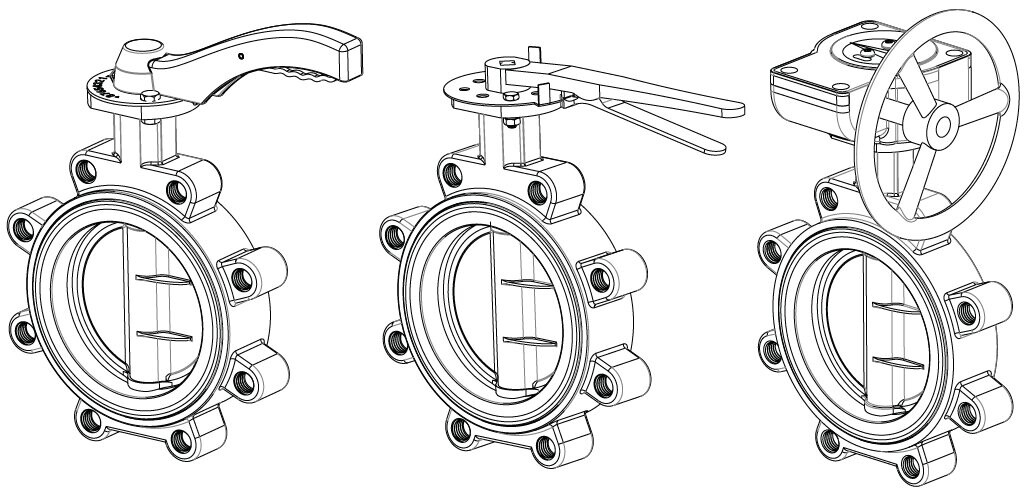Comparative Analysis of Unidirectional vs. Bidirectional Butterfly Valves
Butterfly valves are indispensable components in fluid control systems, playing pivotal roles in various industrial applications. Among the diverse range of butterfly valves, both unidirectional and bidirectional variants are prevalent, each offering unique features and suitability for different scenarios. This article aims to delve into a thorough comparison between these two types of butterfly valves, providing readers with insightful insights to aid in informed decision-making during valve selection.

I. Structural and Functional Differences
II. Advantages Comparison
III. Design and Application Variations
Unidirectional and bidirectional butterfly valves exhibit distinct advantages and considerations in structural design, functional attributes, and application suitability. The selection of the appropriate butterfly valve type mandates a comprehensive evaluation encompassing factors such as medium characteristics, pressure exigencies, and operational ease, thereby ensuring the seamless and efficient operation of fluid control systems.

I. Structural and Functional Differences
1. Flow Direction Requirements:
Unidirectional Butterfly Valve: Effective closure necessitates alignment with the medium flow direction, typically indicated by flow direction arrows on the valve body, demanding meticulous attention during installation.
Bidirectional Butterfly Valve: Offers enhanced flexibility by accommodating both facing and opposing flow directions of the medium, eliminating the need for specific flow direction considerations with the absence of flow direction markings.
2. Stem Stress and Design Variances:
Unidirectional Butterfly Valve: With lower stem stress attributed to its alignment with the medium flow direction, it adopts a simpler design for streamlined operation.
Bidirectional Butterfly Valve: Designed to withstand bidirectional pressures, it features a robust construction with a larger stem diameter to ensure steadfast performance under varying pressure conditions.
3. Sealing Performance:
Unidirectional Butterfly Valve: Constrained by unidirectional sealing, its sealing efficacy is contingent upon flow direction, warranting careful attention during both installation and operation phases.
Bidirectional Butterfly Valve: Harnesses the superior sealing capability of bidirectional metal hard sealing, guaranteeing flawless leakage prevention under both positive and reverse pressure scenarios, presenting a significant advantage in terms of reliability.
Unidirectional Butterfly Valve: Effective closure necessitates alignment with the medium flow direction, typically indicated by flow direction arrows on the valve body, demanding meticulous attention during installation.
Bidirectional Butterfly Valve: Offers enhanced flexibility by accommodating both facing and opposing flow directions of the medium, eliminating the need for specific flow direction considerations with the absence of flow direction markings.
2. Stem Stress and Design Variances:
Unidirectional Butterfly Valve: With lower stem stress attributed to its alignment with the medium flow direction, it adopts a simpler design for streamlined operation.
Bidirectional Butterfly Valve: Designed to withstand bidirectional pressures, it features a robust construction with a larger stem diameter to ensure steadfast performance under varying pressure conditions.
3. Sealing Performance:
Unidirectional Butterfly Valve: Constrained by unidirectional sealing, its sealing efficacy is contingent upon flow direction, warranting careful attention during both installation and operation phases.
Bidirectional Butterfly Valve: Harnesses the superior sealing capability of bidirectional metal hard sealing, guaranteeing flawless leakage prevention under both positive and reverse pressure scenarios, presenting a significant advantage in terms of reliability.
II. Advantages Comparison
1. Advantages of Bidirectional Butterfly Valve:
Bidirectional Sealing Capability: Leveraging stainless steel metal hard sealing technology, it delivers dependable bidirectional pressure resistance, catering to a broader spectrum of applications.
Simplified Structural Design: Characterized by a compact configuration, user-friendly operation, and minimal maintenance requirements, it emerges as the preferred choice across various industrial settings.
2. Features of Unidirectional Butterfly Valve:
Sensitivity to Flow Direction: Despite requiring meticulous consideration of medium flow direction, its distinctive application value remains prominent in specific operational contexts.
Reduced Stem Stress: Suited for light-duty and low-pressure applications, its simpler design translates into cost advantages attributable to lower complexity.
Bidirectional Sealing Capability: Leveraging stainless steel metal hard sealing technology, it delivers dependable bidirectional pressure resistance, catering to a broader spectrum of applications.
Simplified Structural Design: Characterized by a compact configuration, user-friendly operation, and minimal maintenance requirements, it emerges as the preferred choice across various industrial settings.
2. Features of Unidirectional Butterfly Valve:
Sensitivity to Flow Direction: Despite requiring meticulous consideration of medium flow direction, its distinctive application value remains prominent in specific operational contexts.
Reduced Stem Stress: Suited for light-duty and low-pressure applications, its simpler design translates into cost advantages attributable to lower complexity.
III. Design and Application Variations
1. Installation Convenience:
Unidirectional Butterfly Valve: While necessitating attention to medium flow direction during installation, it ultimately ensures reliable operation upon correct installation.
Bidirectional Butterfly Valve: Offering unparalleled flexibility with no specific flow direction requirements, it proves ideal for applications necessitating frequent operational adjustments.
2. Stem Design and Stress Considerations:
Unidirectional Butterfly Valve: With lower stem stress and simpler design, it presents a cost-effective solution for various industrial requirements.
Bidirectional Butterfly Valve: Engineered to endure higher pressures, it caters to demanding high-pressure and high-flow applications, albeit with greater stem stress and complexity.
Unidirectional Butterfly Valve: While necessitating attention to medium flow direction during installation, it ultimately ensures reliable operation upon correct installation.
Bidirectional Butterfly Valve: Offering unparalleled flexibility with no specific flow direction requirements, it proves ideal for applications necessitating frequent operational adjustments.
2. Stem Design and Stress Considerations:
Unidirectional Butterfly Valve: With lower stem stress and simpler design, it presents a cost-effective solution for various industrial requirements.
Bidirectional Butterfly Valve: Engineered to endure higher pressures, it caters to demanding high-pressure and high-flow applications, albeit with greater stem stress and complexity.
Unidirectional and bidirectional butterfly valves exhibit distinct advantages and considerations in structural design, functional attributes, and application suitability. The selection of the appropriate butterfly valve type mandates a comprehensive evaluation encompassing factors such as medium characteristics, pressure exigencies, and operational ease, thereby ensuring the seamless and efficient operation of fluid control systems.

